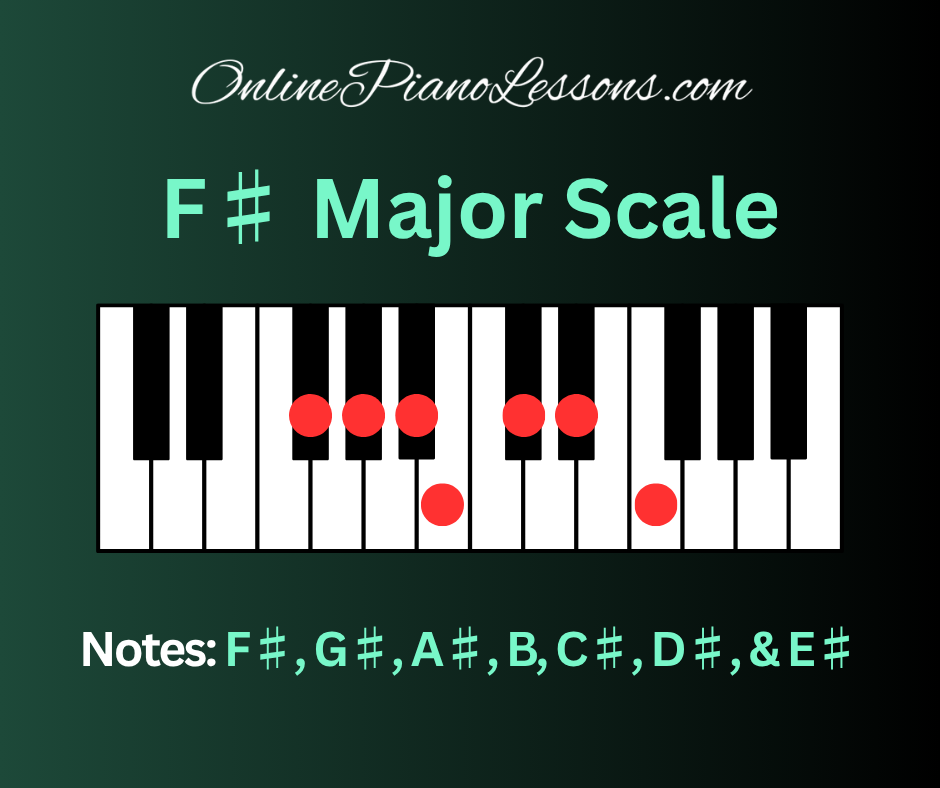
From a theoretical perspective, the F sharp major scale is an essential tool for understanding complex harmonic structures. It reinforces knowledge of sharp key signatures, enharmonic equivalents, and chordal relationships. Many advanced harmonic progressions and modulations in piano compositions pivot through F♯ major to create tension and release.
In jazz and modern harmony, the F♯ major scale is used as a tonal center for modulation, as well as for constructing modes like F♯ Lydian or F♯ Mixolydian when exploring modal jazz improvisation.
Quick Preview: The F sharp major scale (F♯, G♯, A♯, B, C♯, D♯, E♯) is one of the most radiant and powerful keys in music. Though it may seem intimidating at first glance due to its six sharps, this scale is essential for advanced piano players and composers who want to understand the brighter side of sharp key signatures. In this definitive guide, we’ll explore how to play, understand, and apply the F sharp major scale on the piano with confidence.
Understanding the F Sharp Major Scale
The F sharp major scale is a seven-note diatonic scale that follows the same pattern of whole and half steps as every other major scale:
Whole, Whole, Half, Whole, Whole, Whole, Half.
When you apply this pattern starting on F♯, you get the following notes:
F♯ – G♯ – A♯ – B – C♯ – D♯ – E♯
Notice that E♯ is enharmonically equivalent to F natural. However, when written in proper notation, we must keep the letter order consistent — meaning each note letter (A through G) must appear once per scale. That’s why we write E♯ instead of F, maintaining the scale’s theoretical structure.
The F♯ major scale is built on the key signature containing six sharps: F♯, C♯, G♯, D♯, A♯, and E♯.
How to Play the F♯ Major Scale on Piano
When playing the F sharp major scale on the piano, both hands use specific fingering patterns to make it easier to navigate the black keys.
Right Hand Fingering
1 – 2 – 3 – 4 – 1 – 2 – 3 – 4
Start with your thumb (1) on F♯, then continue up the pattern. After the fourth finger lands on B, cross your thumb under to C♯ and continue upward.
Left Hand Fingering
4 – 3 – 2 – 1 – 3 – 2 – 1
Start with your fourth finger on F♯ and cross your thumb under after reaching A♯. Continue ascending through the rest of the notes.
Practicing the F♯ major scale hands separately first helps establish muscle memory before combining them together. The feeling of the alternating black and white keys creates a smooth, rolling motion under the fingers once mastered.
The Sound and Character of the F Sharp Major Scale
Each musical key has its own emotional and tonal quality, and the F sharp major scale is often described as bright, luminous, and deeply resonant. It produces a shimmering, almost crystalline sound on the piano, which makes it ideal for expressive and lyrical playing.
Many composers choose F♯ major when they want to convey:
- Triumph or victory
- Hope and brilliance
- Spiritual or ethereal qualities
Because of its six sharps, this key isn’t commonly used by beginners. However, it appears frequently in advanced piano literature, especially in works by composers such as Chopin, Liszt, and Rachmaninoff.
How the F♯ Major Scale Relates to Other Keys
The F sharp major scale is enharmonically equivalent to the G♭ major scale, meaning they sound identical but are written differently. G♭ major uses six flats instead of six sharps. Pianists often encounter both depending on the piece or key signature chosen by the composer.
Relative Minor
The relative minor of F♯ major is D♯ minor. Both share the same key signature of six sharps, but D♯ minor starts on D♯ and follows the natural minor pattern.
Parallel Minor
The parallel minor of F♯ major is F♯ minor. While they share the same tonic note, the F♯ minor scale contains only three sharps (F♯, C♯, and G♯), creating a darker and more introspective mood compared to the bright sound of the major key.
Using the F♯ Major Scale in Music
In practical playing, the F sharp major scale appears in both classical and modern pieces. Pianists can use it for:
- Warm-up exercises to strengthen finger control on black keys
- Improvisation, especially in jazz and pop music with a brighter harmonic palette
- Composing music that feels uplifting or radiant
Because of its complex key signature, mastering this scale helps pianists become more comfortable reading and interpreting sharp-heavy notation. It also improves your understanding of enharmonic equivalents and advanced harmonic relationships.
Chords Within the F Sharp Major Scale
Every major scale contains seven diatonic chords built from each note of the scale. The F♯ major scale produces the following chords:
- F♯ major (F♯ – A♯ – C♯)
- G♯ minor (G♯ – B – D♯)
- A♯ minor (A♯ – C♯ – E♯)
- B major (B – D♯ – F♯)
- C♯ major (C♯ – E♯ – G♯)
- D♯ minor (D♯ – F♯ – A♯)
- E♯ diminished (E♯ – G♯ – B)
These chords form the harmonic foundation for pieces in the key of F♯ major. Practicing these progressions on the piano helps develop a deeper connection with the scale’s tonality.
Tips for Practicing the F♯ Major Scale
- Use a metronome. Start slow and gradually increase the tempo as you become more comfortable.
- Focus on hand coordination. The smooth transition between black and white keys can feel awkward at first.
- Practice in octaves. Playing the F sharp major scale across multiple octaves builds endurance and accuracy.
- Experiment with dynamics. Play softly, then loudly, to understand the expressive potential of the scale.
- Incorporate arpeggios. Practicing F♯ major arpeggios strengthens your ability to transition fluidly between notes.
Final Thoughts
The F sharp major scale may seem challenging because of its many sharps, but it’s an indispensable part of mastering the piano. Learning this scale not only expands your technical abilities but also deepens your understanding of music theory and enhances your appreciation for the beauty of complex key signatures. Whether you’re performing Chopin’s Études or composing your own melodies, the F♯ major scale provides a brilliant framework for musical expression.
FAQ
What notes are in the F sharp major scale?
The notes are F♯, G♯, A♯, B, C♯, D♯, and E♯.
How many sharps are in the F♯ major scale?
There are six sharps: F♯, C♯, G♯, D♯, A♯, and E♯.
What is the relative minor of F♯ major?
The relative minor is D♯ minor.
Is F♯ major the same as G♭ major?
They sound the same but are written differently. F♯ major uses sharps, while G♭ major uses flats.
Why should pianists learn the F♯ major scale?
It improves fluency on the black keys, enhances reading sharp key signatures, and builds strong finger technique across all 12 major keys.

 Get Full Access (Only $5/mo)
Get Full Access (Only $5/mo)



 I love playing piano, creating new melodies and songs, and further developing my online piano course and making updates/additions to my site OnlinePianoLessons.com!
I love playing piano, creating new melodies and songs, and further developing my online piano course and making updates/additions to my site OnlinePianoLessons.com!  Now that is what I call fun!
Now that is what I call fun!





